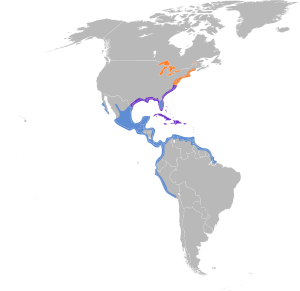Laughing gull facts for kids
The laughing gull (Leucophaeus atricilla) is a medium-sized bird found in North and South America. It's named for its call, which sounds like a laugh! These gulls eat many different things and often scavenge for food. They live and raise their young in big groups called colonies. You can find them mostly along the Atlantic coast, in the Caribbean, and northern South America. There are two main types, or subspecies, of laughing gulls. One lives from Canada down to Central America. The other lives in the Caribbean and near Venezuela.
Quick facts for kids Laughing gull |
|
|---|---|
 |
|
| Laughing gull in flight | |
| Conservation status | |
| Scientific classification | |
| Genus: |
Leucophaeus
|
| Species: |
atricilla
|
 |
|
| Synonyms | |
|
Larus atricilla Linnaeus, 1758 |
|
Contents
What's in a Name?
The scientific name for the laughing gull is Leucophaeus atricilla. The first part, Leucophaeus, comes from ancient Greek words. Leukós means "white" and phaios means "dusky" or "dark".
The second part, atricilla, comes from Latin. Ater means "black" and cilla means "tail". Interestingly, the scientist Linnaeus might have made a small mistake. He probably meant to write "black-headed" instead of "black-tailed". This is because the laughing gull has a black head, but its tail is white!
Where They Live and Travel
Laughing gulls live along the Atlantic coast of North America. They also live in the Caribbean and northern South America.
Some gulls that live farther north fly south for the winter. This trip is called migration. Sometimes, a laughing gull might fly far off course. These rare visitors are called vagrants and can sometimes be seen in western Europe.
Breeding and Nests
Laughing gulls build their nests in large groups called colonies. They prefer coastal marshes and ponds. Their nests are usually on the ground. They make them mostly from grasses. Female gulls lay three or four greenish eggs. The parents take turns sitting on the eggs for about three weeks until they hatch.
How to Identify a Laughing Gull
It's usually easy to spot a laughing gull. They are about 36 to 41 centimeters (14 to 16 inches) long. Their wingspan is quite wide, from 98 to 110 centimeters (39 to 43 inches). They weigh between 203 and 371 grams (7.2 to 13.1 ounces).
Adult Appearance
In summer, adult laughing gulls have a white body. Their back and wings are dark grey. They also have a striking black head. Their wings are much darker than most other gulls of similar size. They have black tips on their wings. Their beak is long and red. In winter, their black head feathers are mostly gone.
Young Gulls
Young laughing gulls take three years to get their full adult feathers. Younger birds are usually darker than adult gulls. First-year gulls are greyer on their underside. They also have paler heads. You can tell second-year gulls apart by their wing patterns.
Subspecies
There are two main types, or subspecies, of laughing gulls:
- L. a. megalopterus: You can find this type along the coast from southeast Canada down through the eastern and southern United States, Mexico, and Central America.
- L. a. atricilla: This type lives in the West Indies and near the islands of Venezuela.
For a long time, the laughing gull was grouped with other gulls in the Larus family. Now, scientists place it in the Leucophaeus family. This change was made by the American Ornithologists' Union.
Gallery
See also
 In Spanish: Gaviota reidora americana para niños
In Spanish: Gaviota reidora americana para niños













